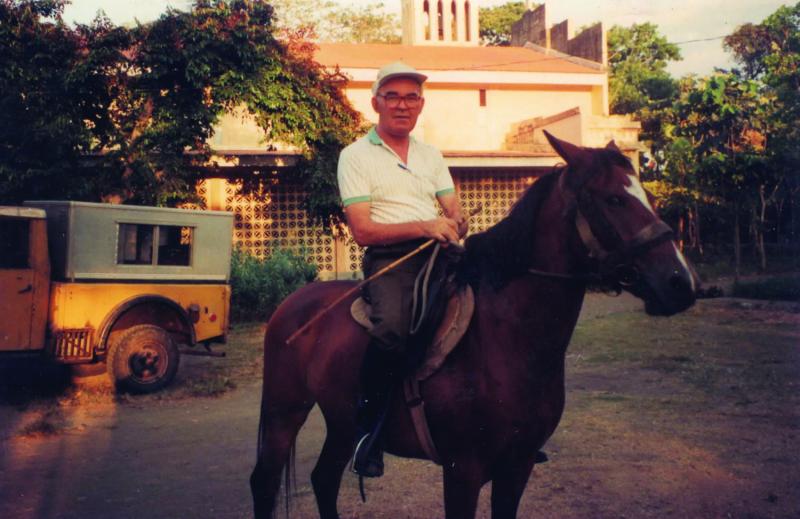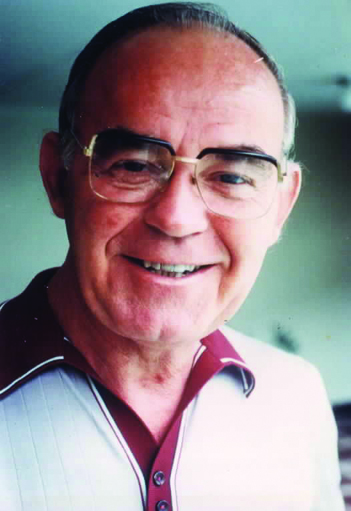Missionary On Horseback
By Fr Michael Doohan SSC
I have long been invited by Misyon to write my vocation story but I always had many excuses to delay it until one day I was cornered. The Misyon staff visited me at my convento in Cauyan, a three-hour journey from Bacolod City, the capital of Negros Occidental. Obviously, I didn’t have much choice but to tell them my vocation story so their visit would not be in vain.

I grew up in County Clare, in the west of Ireland, with four brothers and five sisters. In a poor place like County Clare, farming was the basic livelihood of the people. Our parents taught us the meaning of hard work from an early age and saw to it that we all went to high school. There was only one bad word in our family and that was the word “lazy”. We all did our share – not while we were at school for we were expected to study then – but in the summer and during other holidays. All nine received a full secondary education with the exception of the eldest son, Patrick, who would run the farm.
Easy vocation
I suppose my vocation was easy in the sense that John, my elder brother, had gone ahead of me. After high school, when he announced at home that he was volunteering for the China Mission, as the Columbans were then known in Ireland, I thought he should see a psychiatrist. Just imagine somebody from the mountains volunteering as a missionary in China. He didn’t even know where it was. I really thought it was ridiculous.
John went to the seminary, which was equal to college here, while I went to high school. When I was in first year a visiting priest from St. Columban’s gave a talk in our class on the Chinese Missions. He started his talk with a poem written by another Columban, Fr. Patrick O’Connor.
Who has a blade for a splendid cause?
Who has a heart that’s true?
To live and to fight for the grandest thing
That man could dream or singer sing,
Or ever soldier knew?
The poem struck me and it changed me. I could see where John got caught. I didn’t want it, but it kept at me all the time. Finally I joined the Columbans.

Neophyte
At the time I joined I had never been outside County Clare. Everything was new to me. But I was young and eager so it was easy for me to adapt to a new culture.
I was ordained in 1952 and the following year boarded a cargo ship in San Francisco bound for the Philippines. We had goats for company on our month-long voyage. When I arrived in Manila I was sent to Negros. When I was trying to learn the language on my own without any teacher, apparently I said to Fr. Frank Chapman, the superior in Negros at that time, that I’d better be sent somewhere where there were very few people who spoke English, so that I’d be forced to speak the local language. Fr. Chapman was quoted as having said to the late Fr. Eamonn Gill, who was very good at embellishing stories, “I am giving Mike Doohan his wish to send him where there is very little English and where there is very little of anything else either.”
Missionary on horseback
So Fr. Chapman sent me off on the 24th of June, 1953, to the mountains of Candoni, one of the towns in the south of Negros, during a typhoon. When I got there my predecessor, Fr. Michael McShane, had his bags ready and he left immediately. And there I was. The only thing I knew was that I knew nothing, completely innocent of the culture. The only available transport at that time was two horses: one for the priest and one for the fiscal. That did not worry me because I have liked horses since I was a little boy. My love for horses started probably when I was weaned – at the age of two or three.
Being a parish priest in a mountainous area like Candoni, horses are very useful. In fact up to the present, I still have horses. Horseback riding is also a very good exercise. At the age of 74 I still enjoy half an hour on horseback when I have the time. And talk about psychotherapy, if you want to overcome your problems, get on horseback, and they will be left behind. Nothing else: it’s just you and the horse.
Heart for the trees
Candoni should have been almost a virgin forest. But when I first came many rich people had logging concessions. They cut down trees in the forest almost every week. Trains of carabaos, loads of timber and rattan were being hauled in from the mountain. All for export off to the American market, or to the Japanese market, while those countries were preserving their own forests and buying cheaply form us.
I suppose it was there that I began to have a concern for trees and the forest. But what really struck me was one day when I was on my way to a barrio beyond Bantayan. My regular route was through the forest by horse. This time I had to leave the horse behind because, we could not get through. Trees were cut down, hundreds and hundres of them, just for burning, because it was too far to take them out for lumber.
The kaingeros then claimed the area with fallen trees. That really concerned me because in one hectare of forest knocked down by kaingeros the value of one tree alone would be bigger than all the rice they would reap from one year’s planting. After that they would abandon the area and move on to another.
This time, it’s education
Then in 1974 I was transferred as chaplain to SONEDCO (Southern Negros Development Corporation), a sugar milling company. There was no house, no chapel. So I asked a landowner if he could donate one hectare of land for the church. And he did. My first house was only 8 x 12 ft. For a bath, I went to a river down below; for my toilet, I went to the neighboring hospital. My mesmerized visitors had to sit on the floor. I was lucky when eventually a couple next door gave me four stools and a table. I lived there for 11 years and those years were in fact among the happiest in my life.
In my first year there in the sugar central, I saw many young people hanging around all day, doing nothing. The only thing I could think of was one thing I was interested in – mechanics. I thought of putting up a vocational training center for mechanics for them to make a living somehow. I went over to Cebu, got a teacher from a government school to teach. I also got in contact with Don Bosco, one of the best schools in mechanics. In 1976, the school was opened. The students studied free of charge. Foreign aid also came in the form of equipment and Dutch volunteers. The school became successful. A number of our graduates were even able to work overseas. When the time came for me to leave for a new assignment, there was no priest who knew enough about mechanics to take it over. So, we handed over the school to the government with the condition that it remain a free school and for the poor only. It is still like that.
Happy with Filipinos
Presently I am assigned in Cauyan, where I have been serving for 15 years now. Cauyan is a big parish with 30,000 Catholics. When I was asked where would I like to retire, I said, “I prefer not to retire.” I have plenty of parochial work to do here, not to mention the many friends I have come to love as my own family. Our Filipino people are generally happy people. They always smile, ready to give love and care. I am much more at home here than in Ireland where I now know very few people.
If you are going to have a happy life as a priest, it must be dedicated. A priest has to be happy with his environment, where he is assigned. He has to have time for the people, make himself an instrument for a happy community. And if we don’t say a minimum of prayers, there is no hope of continuing. This is what I have come to learn in my 50 years of being a missionary priest. And I thank all who have helped me along the way.
